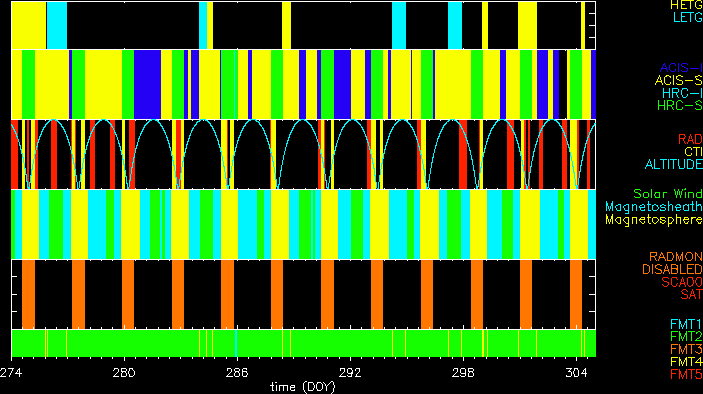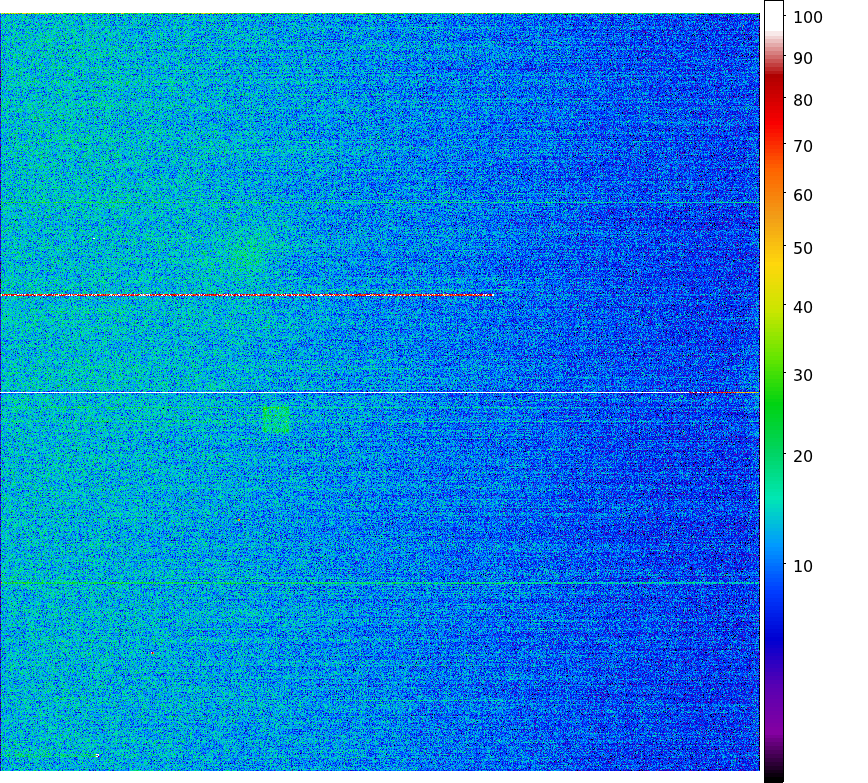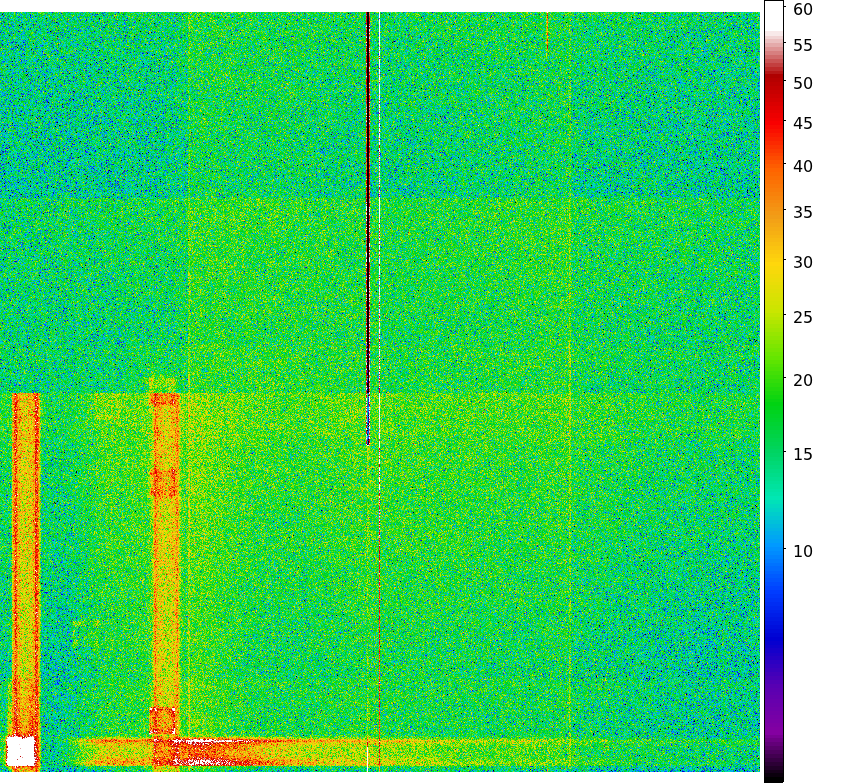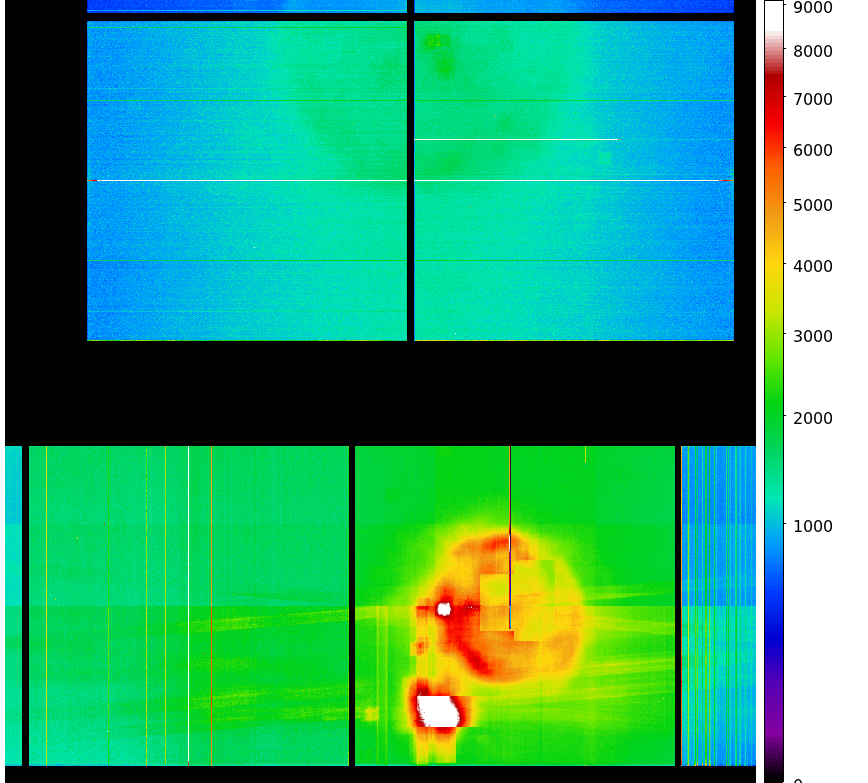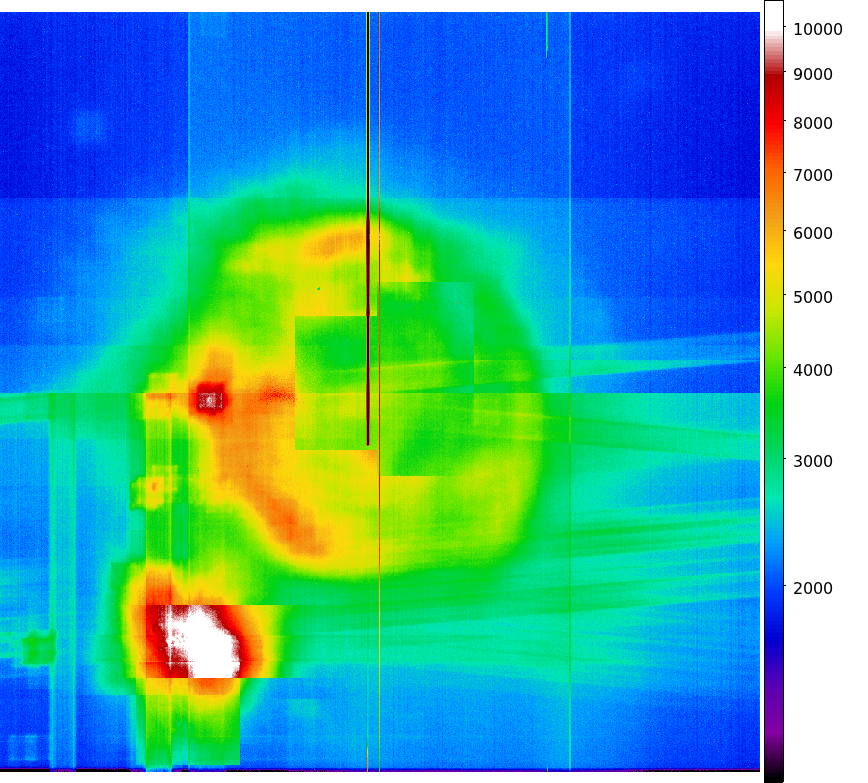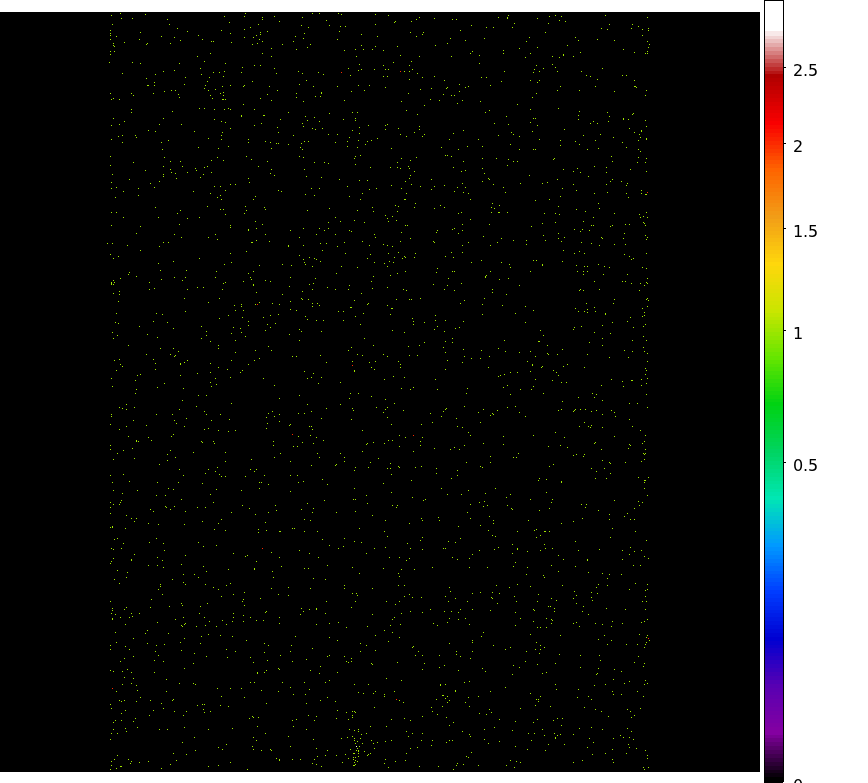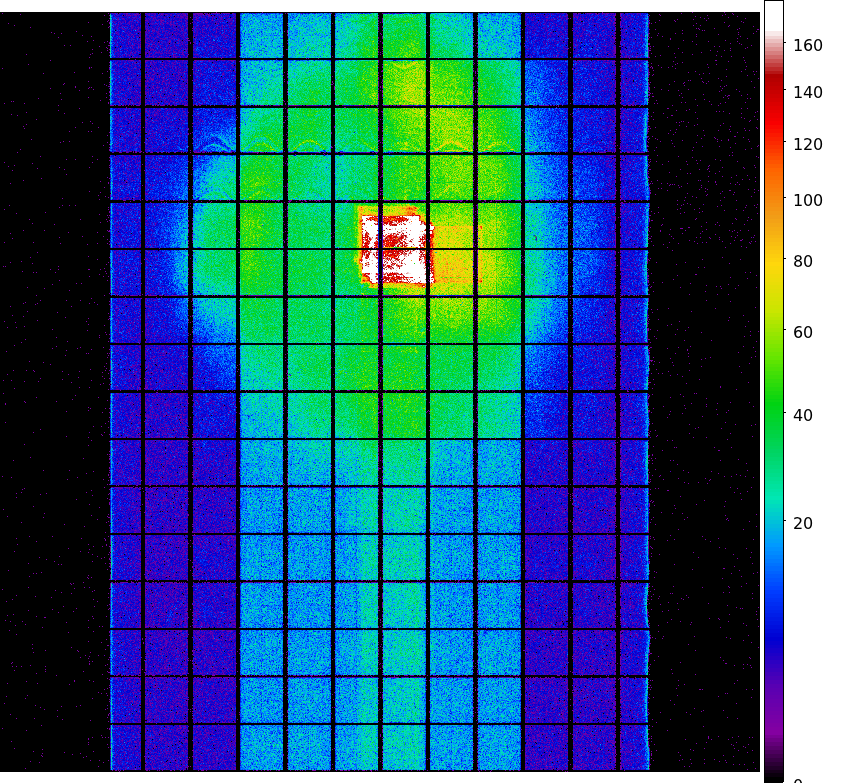ACIS
ACIS DOSE Registered-Photon-Map
The steps we took to compute the dose map are;
- Level 1 Event files for a specified month are obtained from archive.
- Image data including I2, I3, S2, S3 CCDs are extracted from all event files.
- All the extracted image data were merged to create a month long exposure map for the month.
- The exposure map is opened with ds9, and check a distribution of count rates against energy. From this, estimate the upper threshold value. Any events beyond this upper threshold are assumed erroneous events such as bad pixels.
- Using this upper threshold, the data is filtered, and create a cleaned exposure map for the month.
- The exposure map from each month from the Sep 1999 is added up to create a cumulative exposure map for each month.
- Using fimgstatistic, we compute count rate statistics for each CCDs.
- For observations with high data drop rates (e.g., Crab nebula, Cas A), we corrected the observations by adding events.
-
Note: Counts and RMS's of Cumulative maps are lower than the previous months.
This is because we excluded extreme outliers.
Please check more detail plots at Telemetered Photon Dose Trend page.
Statistics: # IMAGE NPIX MEAN RMS MIN MAX ACIS_oct09 6004901 10.652 14.960 0.0 758.0 I2 node 0 262654 10.938129 4.128998 0.0 65.0 I2 node 1 262654 11.772860 4.774640 0.0 399.0 I2 node 2 262654 11.502987 4.226613 0.0 78.0 I2 node 3 262654 11.800723 4.561637 0.0 75.0 I3 node 0 262654 11.248907 4.243506 0.0 59.0 I3 node 1 262654 12.088493 11.760642 0.0 449.0 I3 node 2 262654 10.882863 4.100708 0.0 69.0 I3 node 3 262654 10.817703 4.141590 0.0 207.0 I2 node 0 262654 14.217923 5.055142 0.0 678.0 I2 node 1 262654 14.765784 5.590532 0.0 110.0 I2 node 2 262654 15.800919 5.458552 0.0 144.0 I2 node 3 262654 16.482513 5.400469 0.0 671.0 I3 node 0 262654 19.097124 9.733109 2.0 181.0 I3 node 1 262654 18.340243 6.255880 0.0 100.0 I3 node 2 262654 17.291536 4.464105 2.0 154.0 I3 node 3 262654 15.500969 4.095921 1.0 88.0
Statistics: IMAGE NPIX MEAN RMS MIN MAX ACIS_total 6004901 1319.93 1788.35 0.0 80575.0 I2 node 0 262654 1040.802280 190.468682 0.0 4875.0 I2 node 1 262654 1103.649038 261.660150 0.0 19109.0 I2 node 2 262654 1141.469353 245.328352 0.0 8590.0 I2 node 3 262654 1140.033099 290.911373 0.0 27429.0 I3 node 0 262654 1203.952552 297.337796 0.0 5931.0 I3 node 1 262654 1264.318890 916.006249 0.0 23885.0 I3 node 2 262654 1089.584073 191.581752 0.0 4861.0 I3 node 3 262654 1074.720856 202.473109 0.0 19840.0 I2 node 0 262654 1583.710076 211.066096 789.0 19905.0 I2 node 1 262654 1681.450229 349.312101 818.0 8930.0 I2 node 2 262654 1864.863239 343.940528 1060.0 12680.0 I2 node 3 262654 1799.791169 249.121182 1037.0 25665.0 I3 node 0 262654 2719.738882 1323.006057 1125.0 11165.0 I3 node 1 262654 3940.968141 1809.486365 0.0 12034.0 I3 node 2 262654 2930.109187 828.268085 1027.0 6735.0 I3 node 3 262654 2230.797347 354.806429 1183.0 8572.0
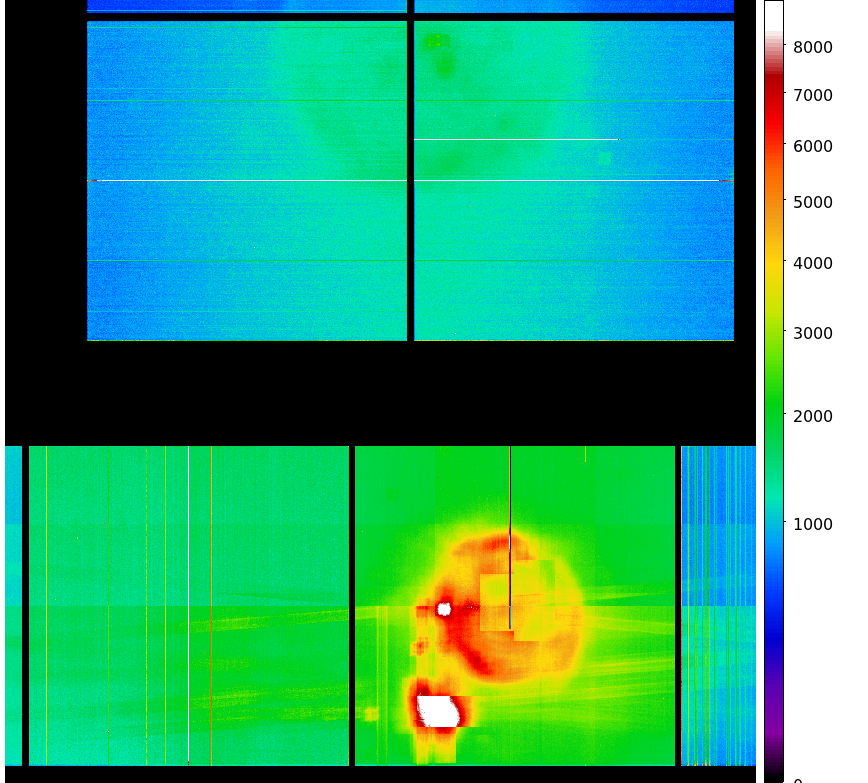
|
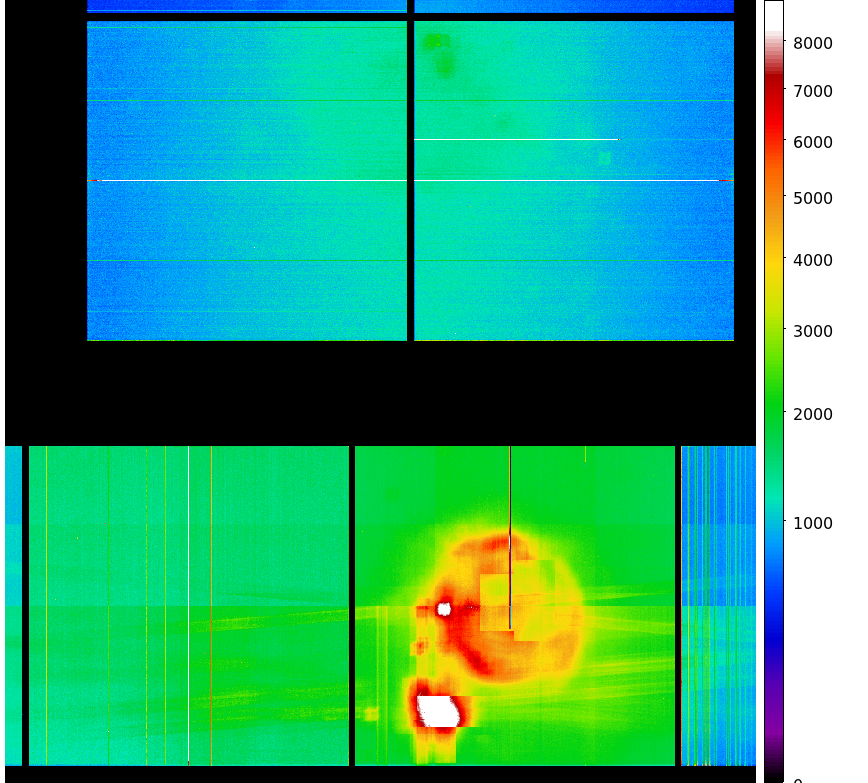
|
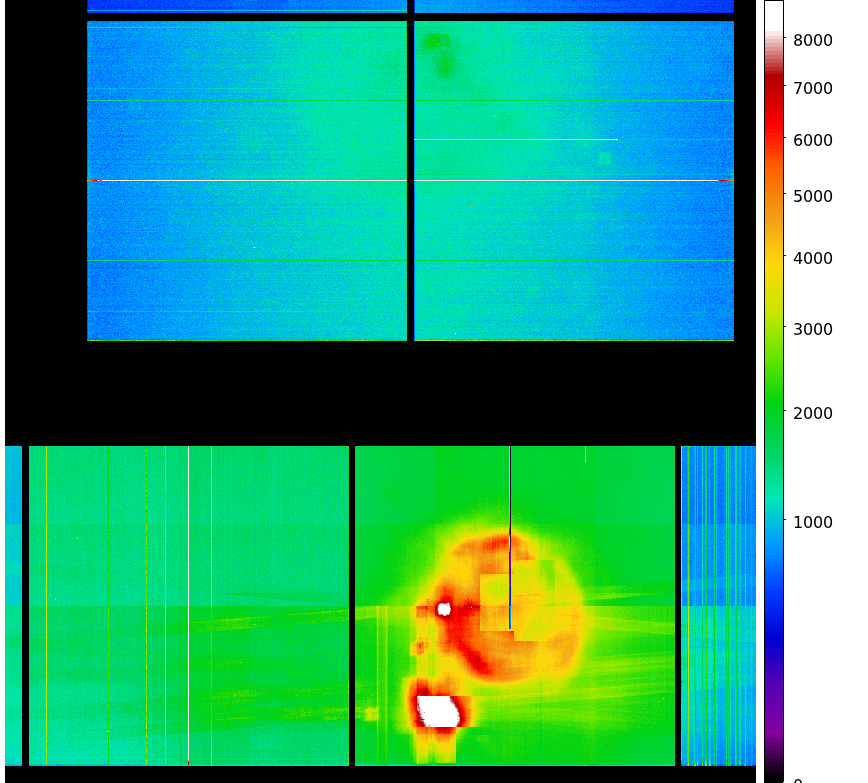
|

|
| Jun 2009 | Mar 2009 | Dec 2008 | Oct 2008 |
|---|
The Mean Detrended CTI
We report CTIs with a refined data definition. CTIs were computed for the temperature dependency corrected data. Please see CTI page for detailed explanation. CTI's are computed for Mn K alpha, and defined as slope/intercept x10^4 of row # vs ADU. Data file: here
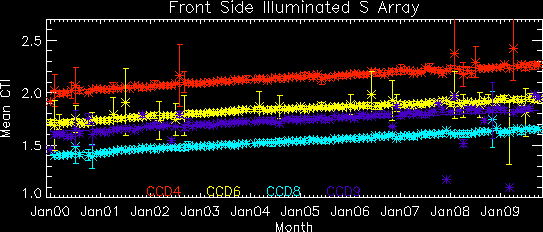


Focal Plane Temperature
October 2009 Focal Temperature
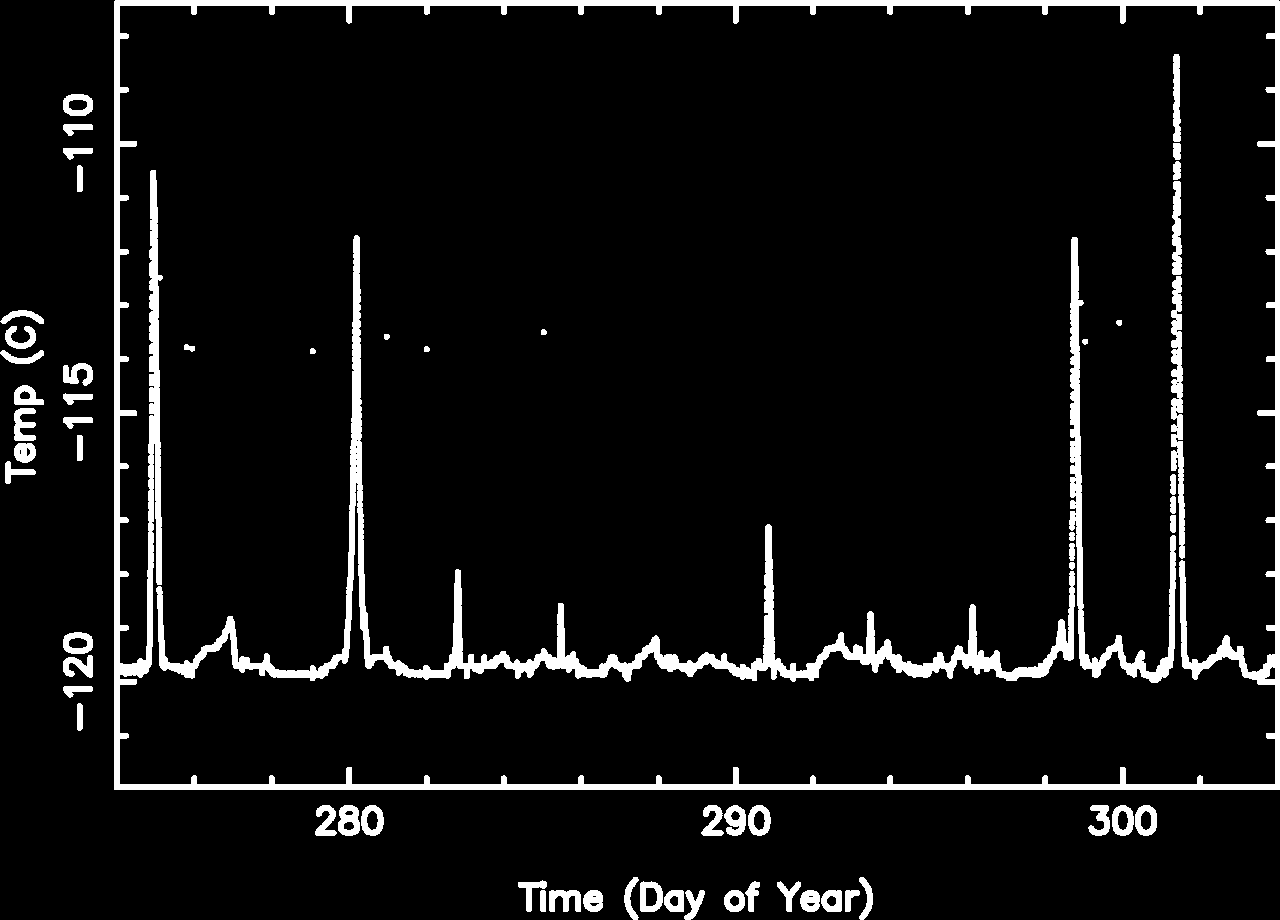
| The Mean (max) FPT: | |
|---|---|
| -116.35 | +/- 3.76 C |
| Mean Width: | |
| 0.41 | +/- 0.43 days |
Averaged Focal Plane Temperature
We are using 10 period moving averages to show trends of peak temperatures and peak widths. Note, the gaps in the width plot are due to missing/corrupted data.
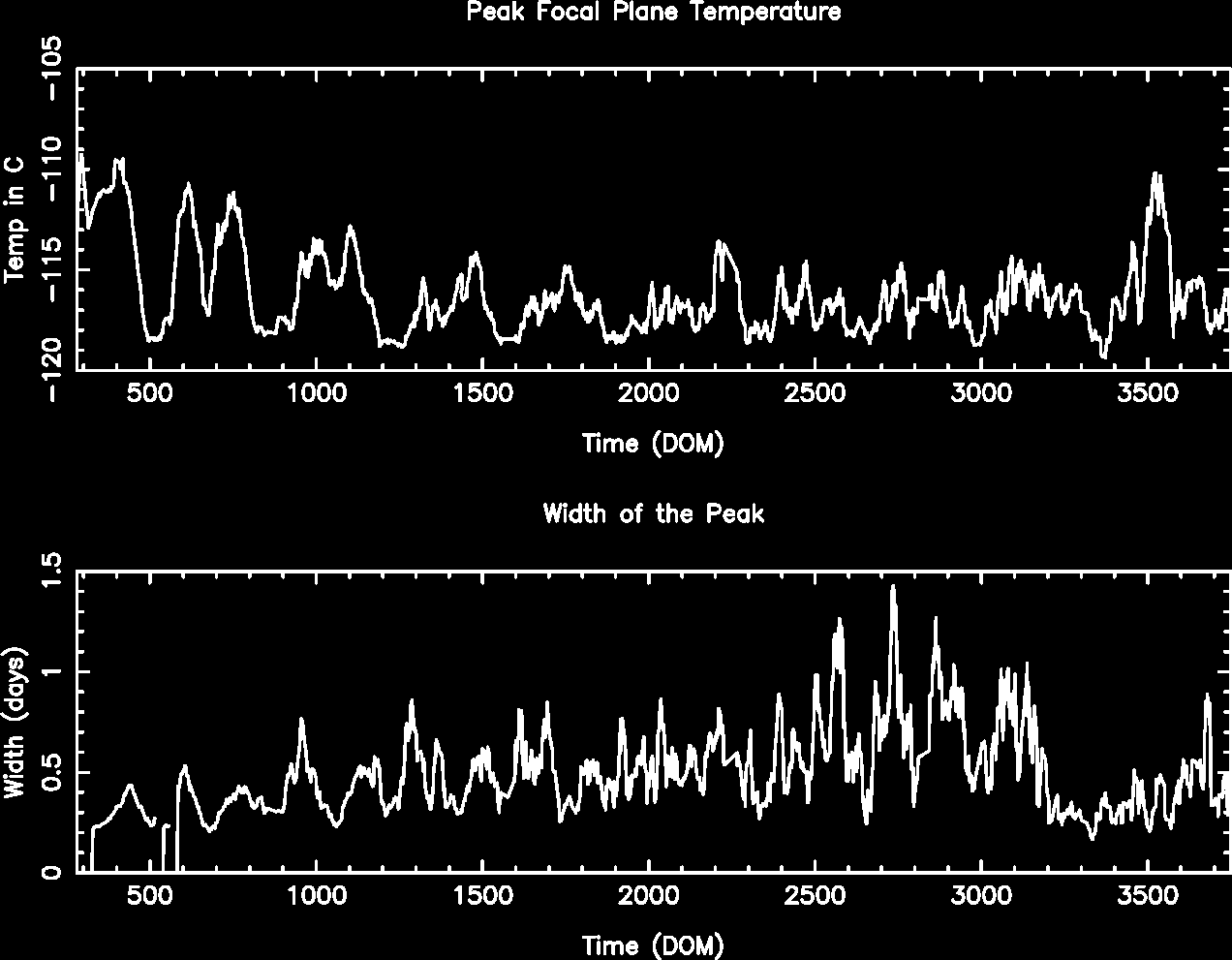
Focal Plane Temperature and Sun Angle, Earth Engle, and Altitude

Bad Pixels
The plots below were generated with a new warm pixel finding script. Please see Acis Bad Pixel Page for details.
Front Side CCDs
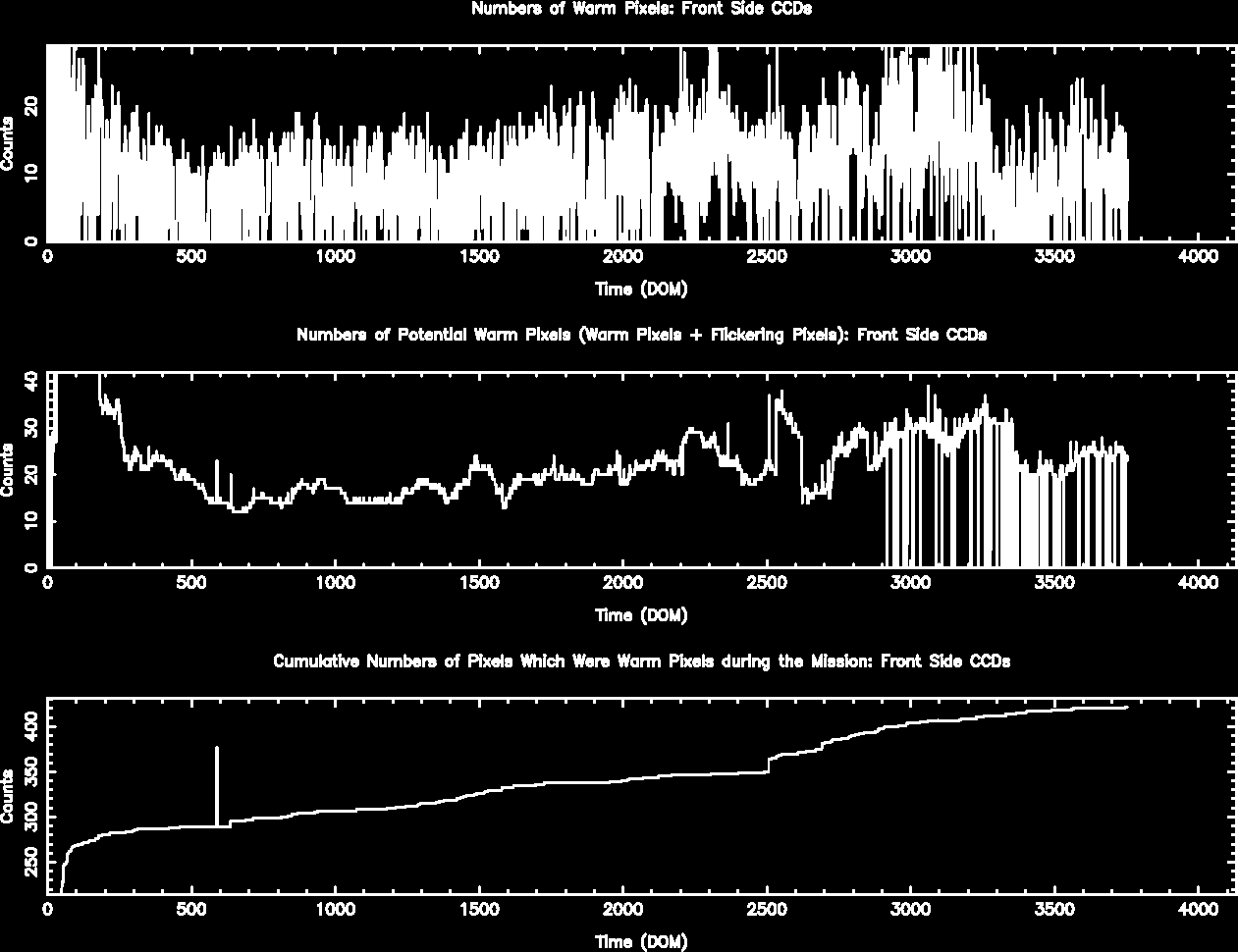
Back Side CCD (CCD5)
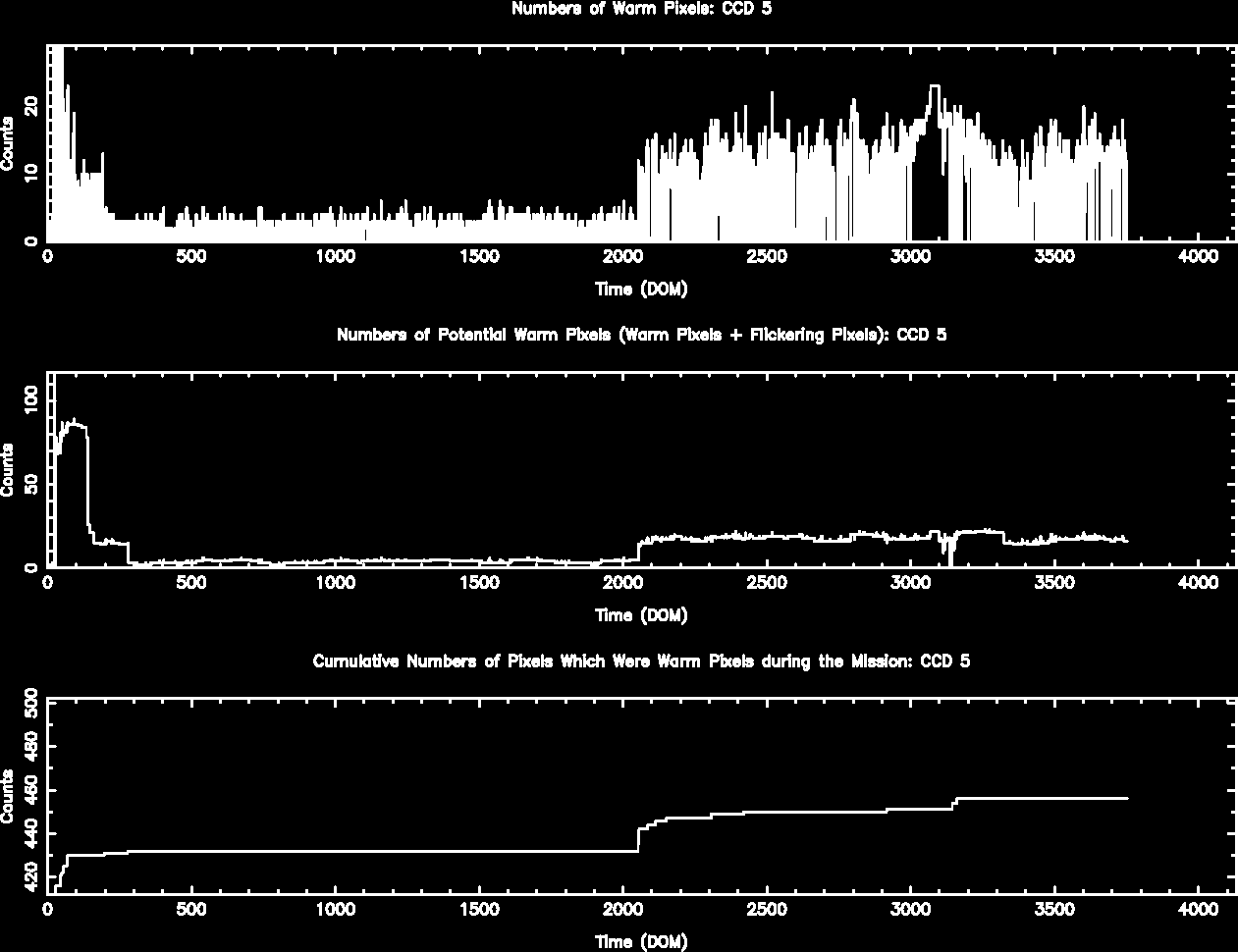
Science Instrument Background Rates
| Name | Low (keV) | High(KeV) | Description |
|---|---|---|---|
| SSoft | 0.00 | 0.50 | Super soft photons |
| Soft | 0.50 | 1.00 | Soft photons |
| Med | 1.00 | 3.00 | Moderate energy photons |
| Hard | 3.00 | 5.00 | Hard Photons |
| Harder | 5.00 | 10.00 | Very Hard photons |
| Hardest | 10.00 | Beyond 10 keV |

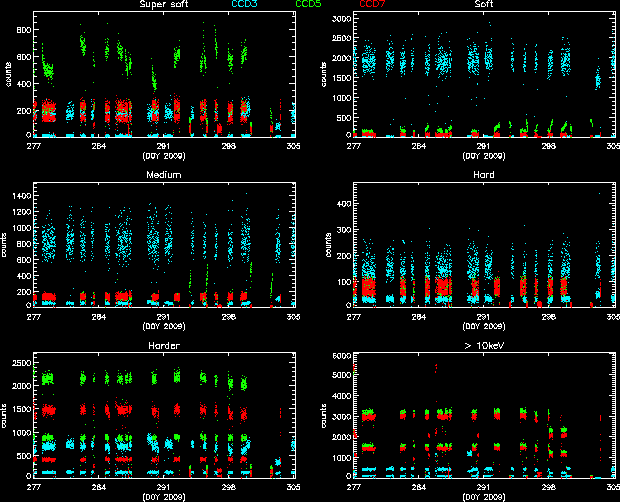
HRC
DOSE of Central 4K Pore-Pairs
Please refer to Maximum Dose Trends for more details.
IMAGE NPIX MEAN STDDEV MIN MAX
HRCI_10_2009.fits 16777216 0.015 0.038 0.0 2.0
IMAGE NPIX MEAN STDDEV MIN MAX
HRCI_08_1999_10_2009.fits 16777216 2.831 3.694 0.0 290.0
IMAGE NPIX MEAN STDDEV MIN MAX
HRCS_10_2009.fits 16777216 0.005 0.070 0.0 3.0
IMAGE NPIX MEAN STDDEV MIN MAX
HRCS_08_1999_10_2009.fits 16777216 12.491 20.630 0.0 1578.0
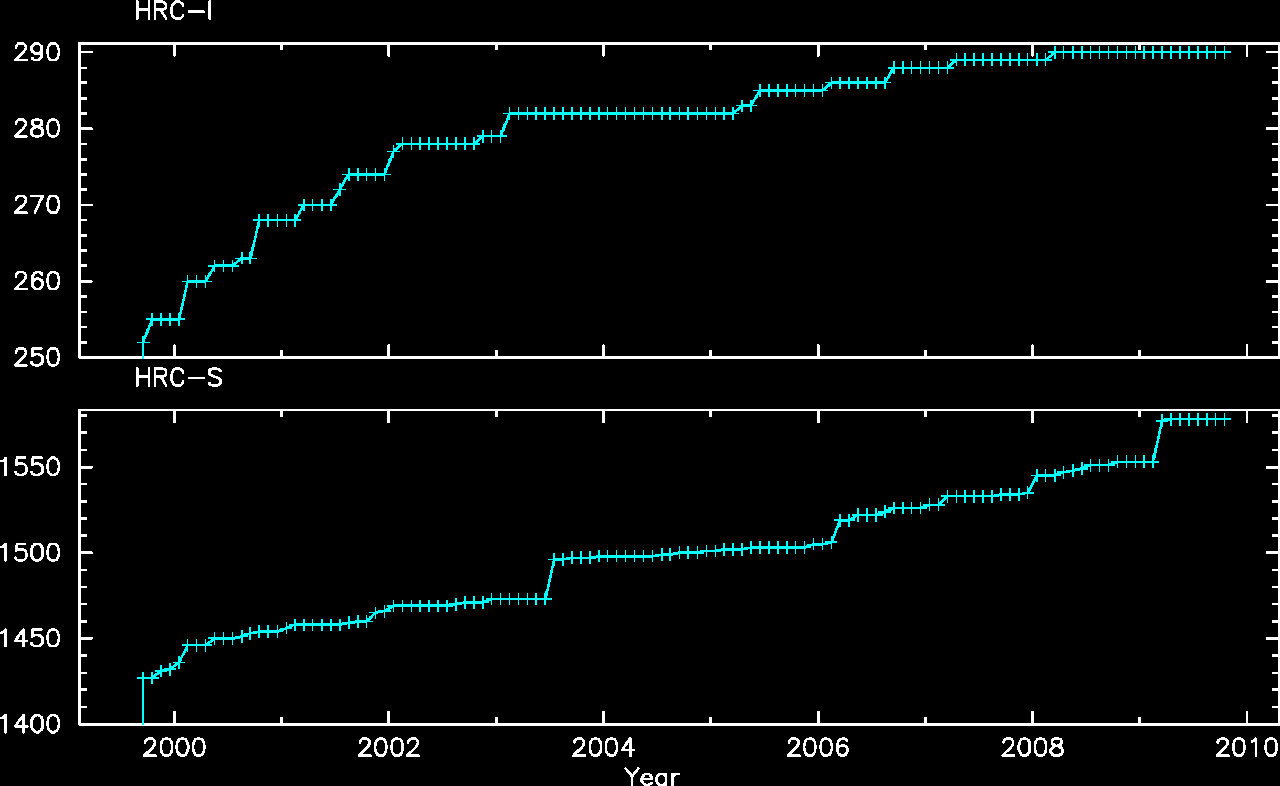
|
|
Max dose trend plots corrected for events that "pile-up"
in the center of the taps due to bad position information.
|
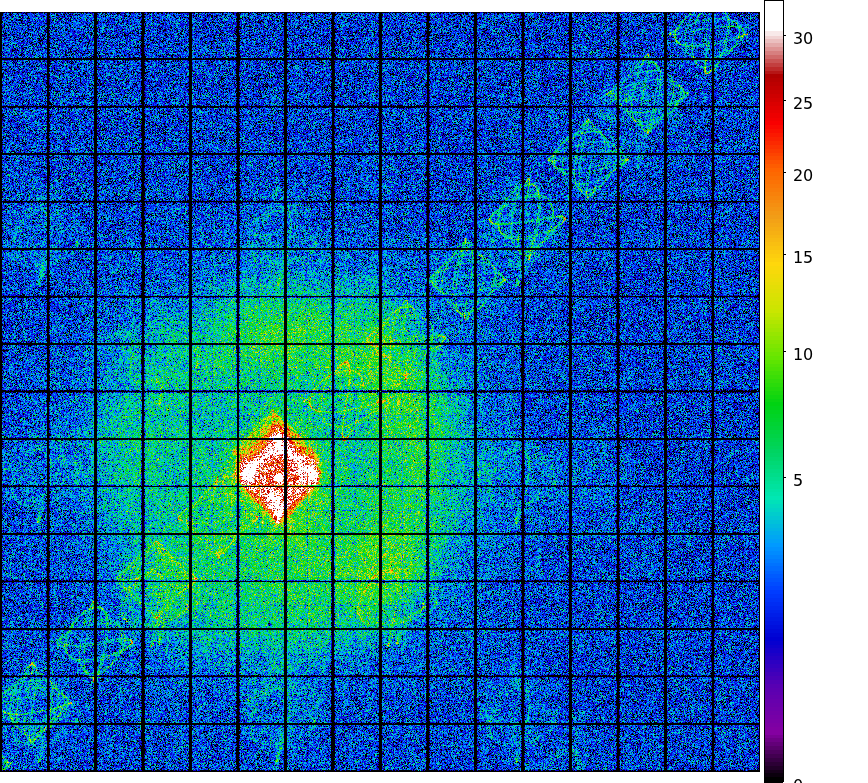
|
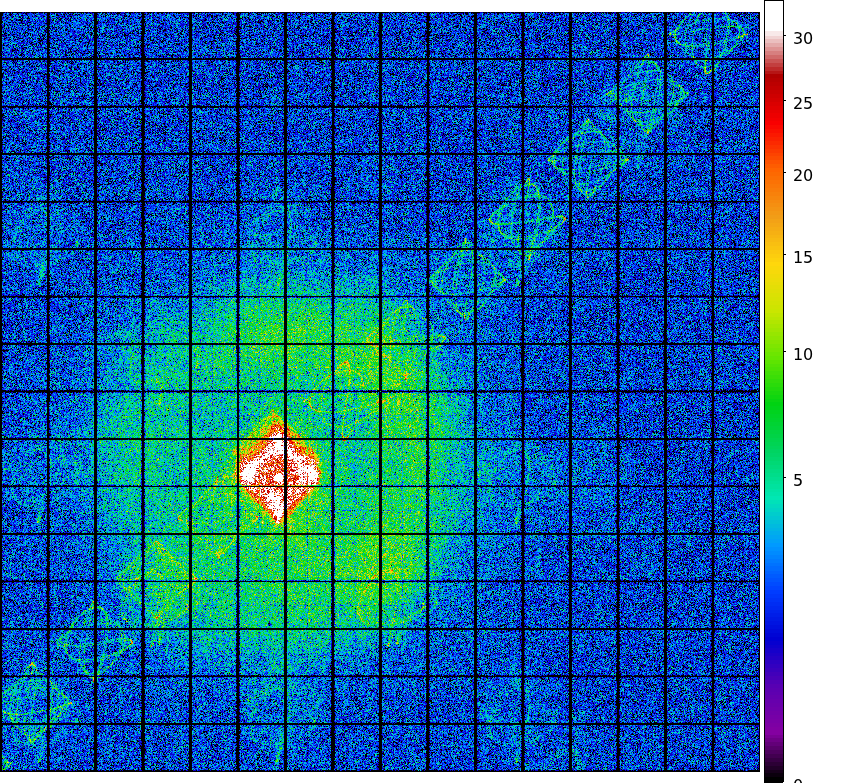
|
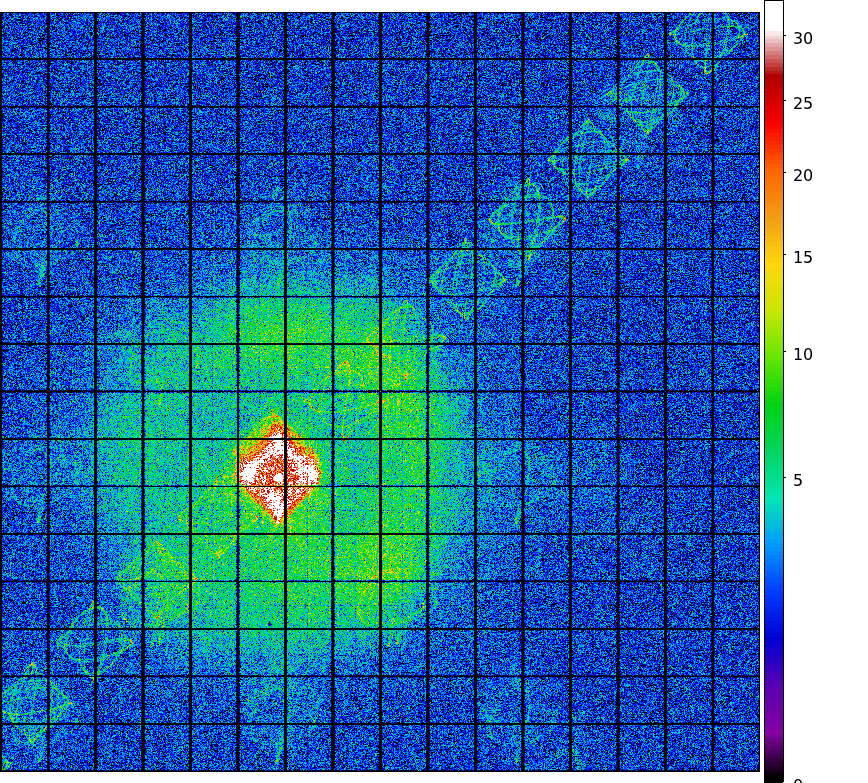
|
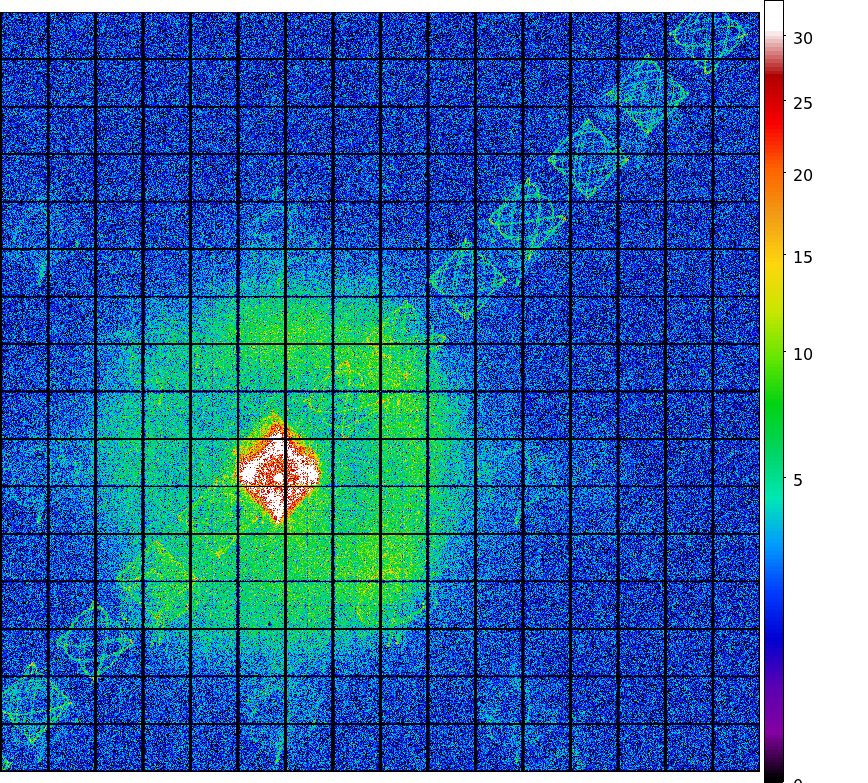
|
| Jun 2009 | Mar 2009 | Dec 2008 | Oct 2008 |
|---|
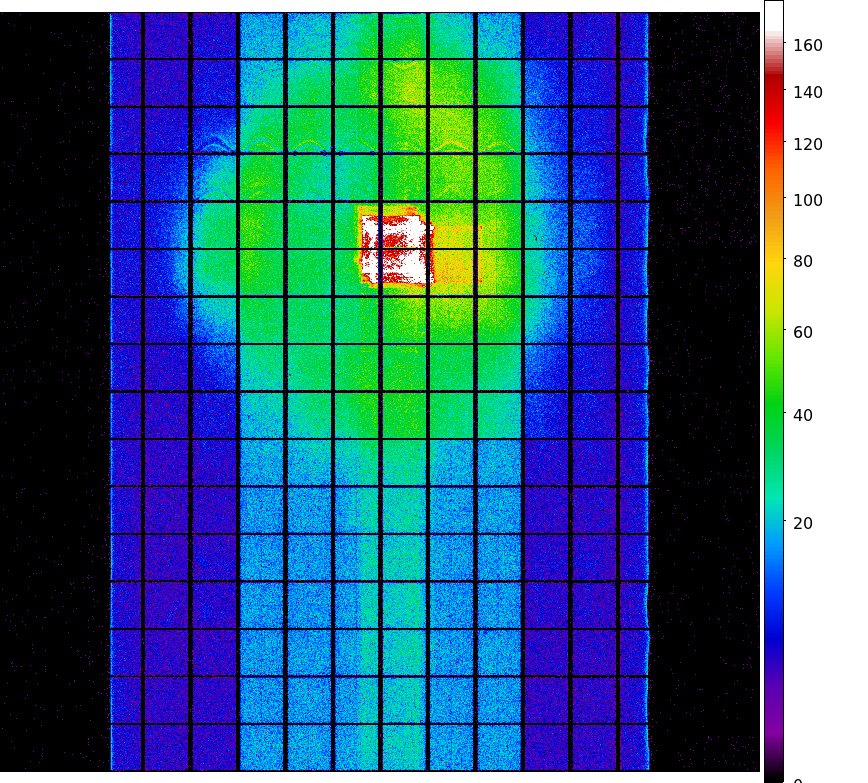
|

|
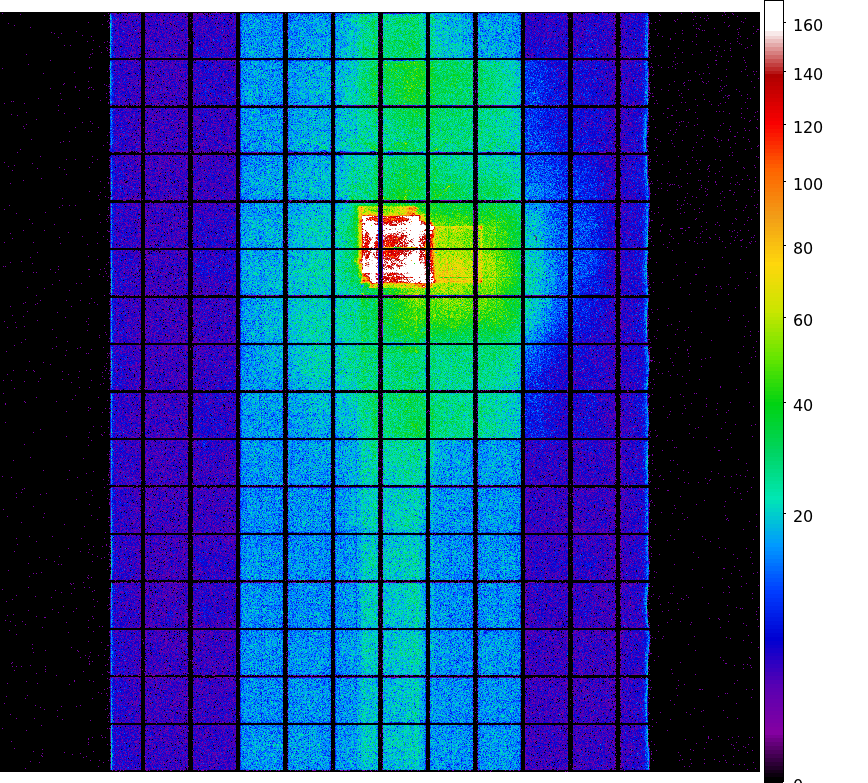
|
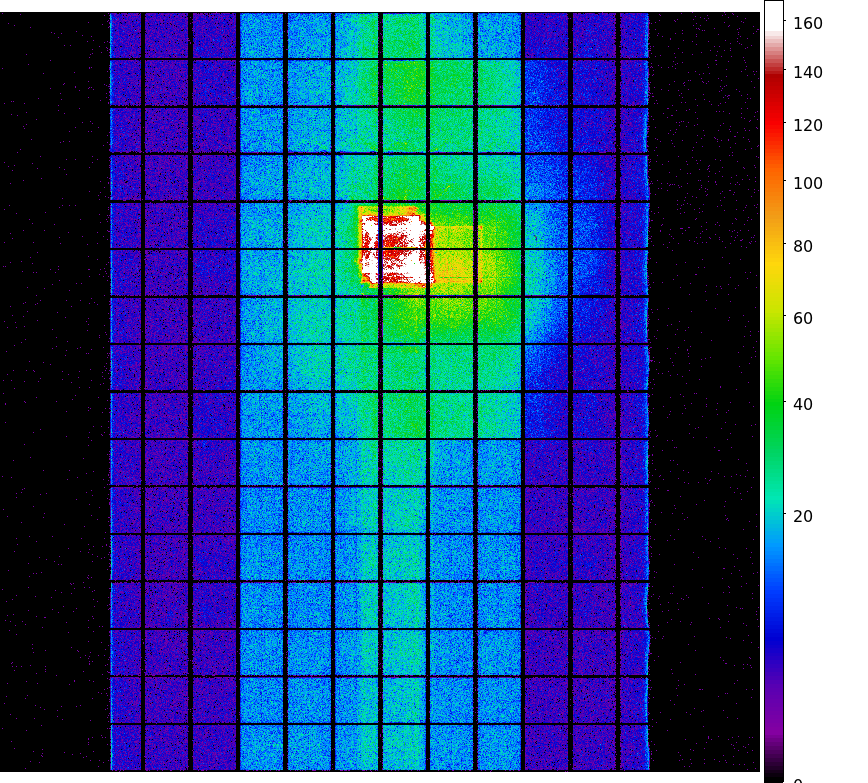
|
| Jun 2009 | Mar 2009 | Dec 2008 | Oct 2008 |
|---|
Gratings
Focus
We plot the width of the zero order streak of ACIS/HETG observations and the width of the zero order image for HRC/LETG observations of point sources. No significant defocusing trend is seen at this time. See Gratings Focus pages. (NOTE: the figures are not updated from Mar 2009 due to a system problem.)
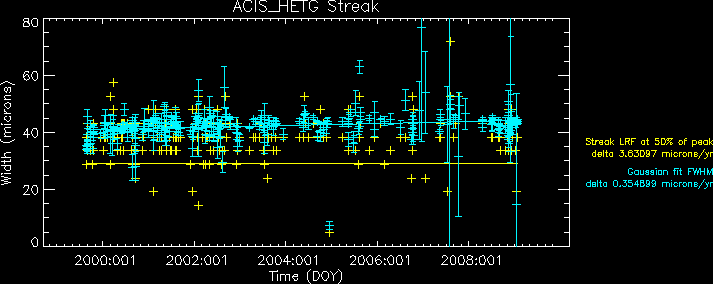
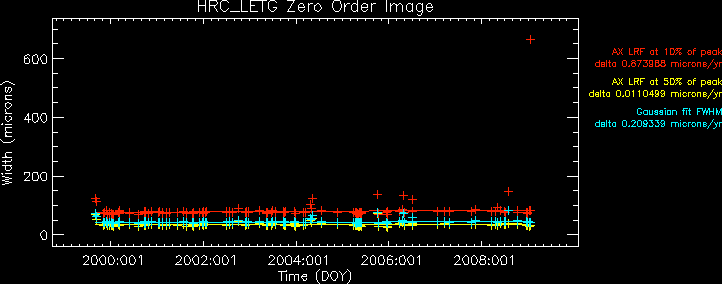
Gratings Resolving Power
We plot E/dE vs. E for fits to detected lines with fwhm_error/fwhm less than 0.15 for the plus and minus arms of HEG, MEG, and LEG. Also shown are conservative (dotted line) and optimistic (dashed line) pre-launch resolving power expectations.
We have selected only calibration observations of Capella, HR1099, and Sigma Gem. See MIT technotes for a parallel analysis.
| Plot symbol indicates dispersion arm: | Color indicates observation date: |
Minus side = cross (x) |
2002-2004 blue 2005-2006 yellow 2007-2009 orange |
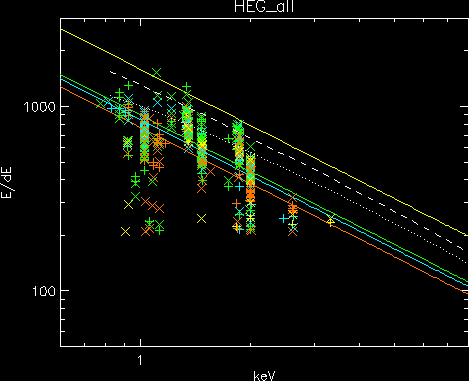
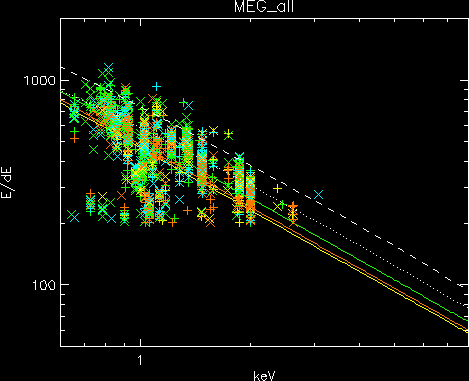
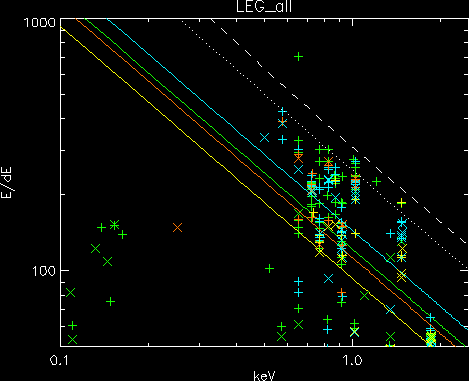
PCAD
ACA Trending
Gyro Bias Drift
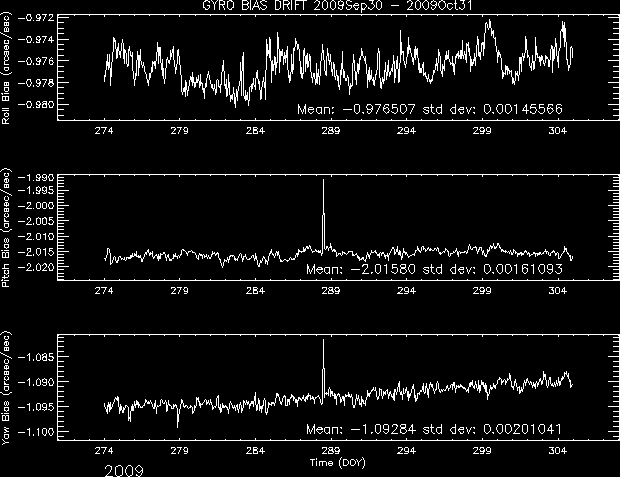
-->
Radiation History
Radiation Zone Timing
Plotted below are radiation zone timing plots based on the following definitions of radiation zone:
- RADZONE - Ephin levels (in any of the E1300,P4GM,P41GM channels) are more than 1/3 of RADMON safing thresholds.
- RADMON - Radmon is disabled for radiation zone (as commanded based on OFLS model, for comparison with actual radiation levels).
- PERIGEE - Time of closest earth approach (for comparison)
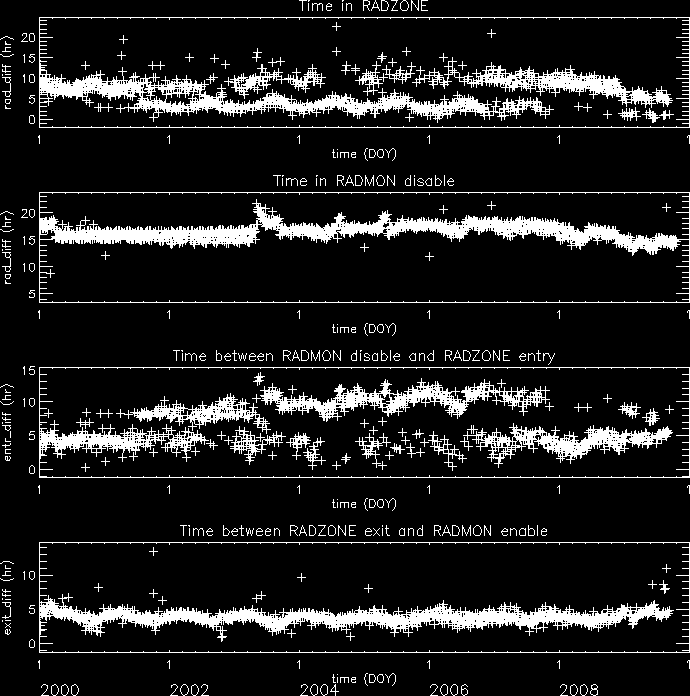
Radiation Count Rates of Oct 2009
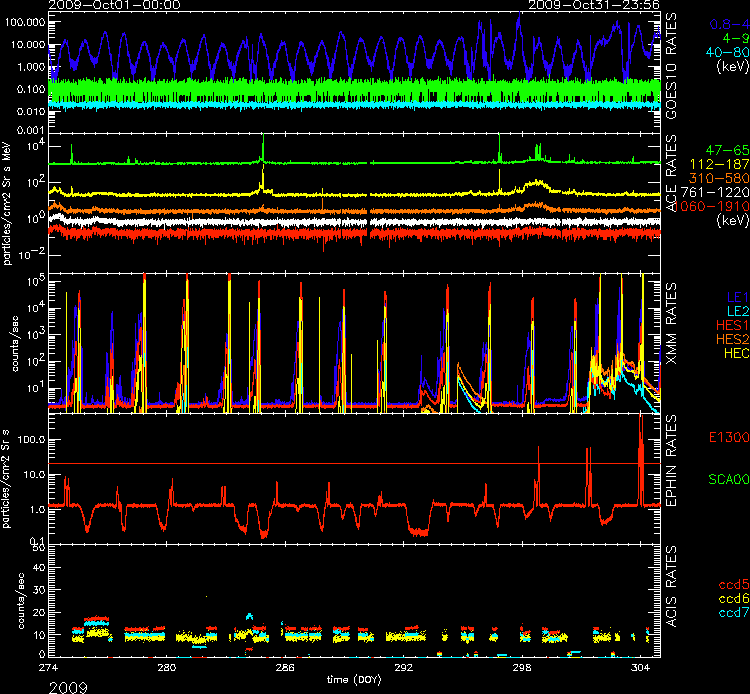
Sun Spot History

SIM
SIM Shift and Twist
SIM Shift and Twist Trend The following plots show trends of SIM shifts (dy and dz) and twist (dtheta). All quantities are directly taken from pcaf*_asol1.fits files. The units are mm for dy and dz, and degree for dtheta. We fit three lines separated before and after (Days of Mission)= 1400 (May 21, 2003), and 2700 (Dec 11, 2006). The unit of slopes are mm per day or degree per day.
The sudden shift around DOM = 1400 and 2700 are due to fid light drift (see a memo by Aldcroft fiducial light drift). On the dtheta plot, two tracks are clearly observed. The track around 0.01 is due to HRC-I, and all others are clustered around -0.002. For more detail, please see SIM Shift and Twist Trend page
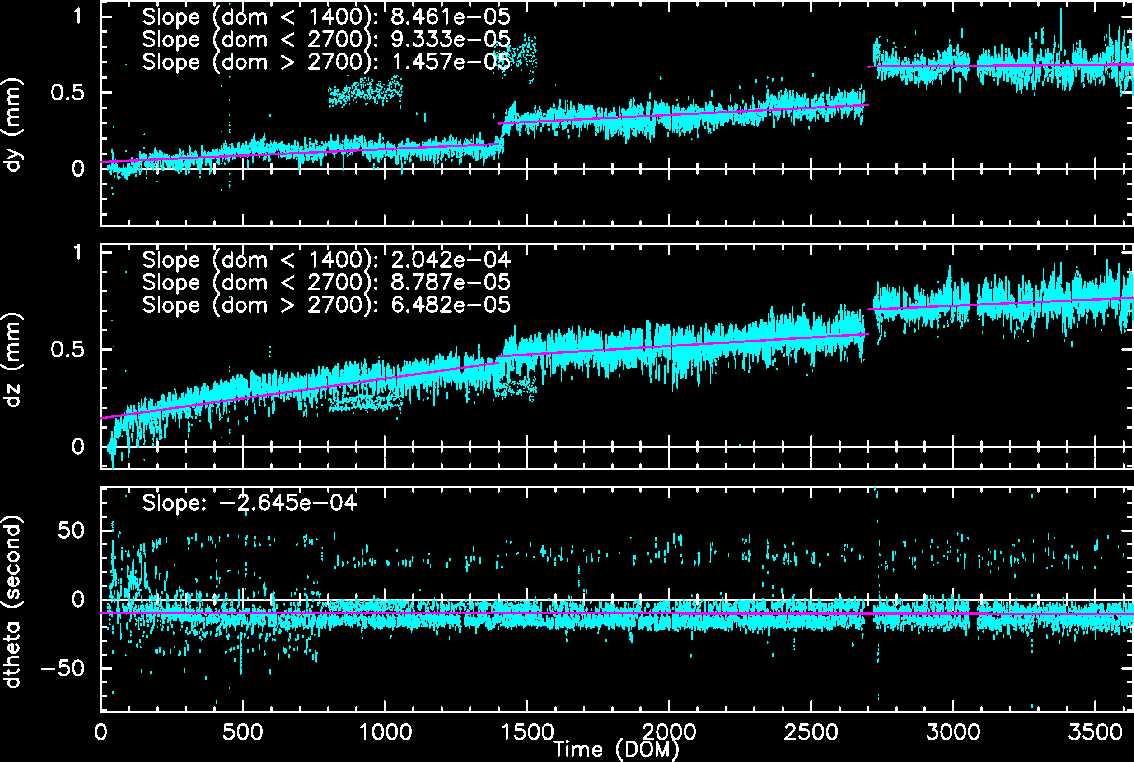
Trending
Quarterly Trends
| Ephin Temperature/Voltage | ||||||
|---|---|---|---|---|---|---|
| MSID | MEAN | RMS | DELTA/YR | DELTA/YR/YR | UNITS | DESCRIPTION |
| HKEBOXTEMP | 319.75 | 3.67 | 5.468e+00 | 7.543e+00 | K | EPHIN HOUSEKEEPING EBOX: TEMPERATURE (5EHSE300) |
| HKN6I | 73.11 | 0.27 | 7.190e-01 | -3.071e+00 | AMP | HK 6 Volts Rail - Current |
| TEIO | 311.67 | 15.80 | 5.467e+01 | -2.165e+02 | K | EPHIN ELECTRONICS HOUSING TEMP |
| TEPHIN | 315.09 | 3.73 | 7.603e+00 | -1.019e+01 | K | EPHIN SENSOR HOUSING TEMP |
| MUPS | ||||||
|---|---|---|---|---|---|---|
| MSID | MEAN | RMS | DELTA/YR | DELTA/YR/YR | UNITS | DESCRIPTION |
| PLINE01T | 288.61 | 1.89 | 3.603e+00 | 5.723e+00 | K | PROP LINE TEMP 01 |
| PLINE02T | 310.99 | 8.66 | 5.279e+01 | 1.810e+02 | K | PROP LINE TEMP 02 |
| PLINE03T | 310.12 | 10.83 | 6.383e+01 | 2.221e+02 | K | PROP LINE TEMP 03 |
| PLINE04T | 295.15 | 9.72 | 6.214e+01 | 1.772e+02 | K | PROP LINE TEMP 04 |
| PLINE05T | 294.77 | 6.93 | 4.906e+01 | 7.097e+01 | K | PROP LINE TEMP 05 |
| PLINE06T | 288.14 | 4.82 | 2.287e+01 | -5.308e+01 | K | PROP LINE TEMP 06 |
| Spacecraft Main Temperature | ||||||
|---|---|---|---|---|---|---|
| MSID | MEAN | RMS | DELTA/YR | DELTA/YR/YR | UNITS | DESCRIPTION |
| TCYLAFT1 | 294.05 | 3.43 | 2.761e+01 | -7.197e+01 | K | CNT CYL TEMP:16-IN FWD OF SC-TS FIT-1 |
| TCYLAFT6 | 293.53 | 3.82 | 3.280e+01 | -1.103e+02 | K | CNT CYL TEMP:16-IN FWD OF SC-TS FIT-6 |
| TSAMYT | 319.18 | 0.99 | 1.274e+01 | 3.622e+01 | K | -Y WING SOLAR ARRAY TEMP |
| TSAPYT | 318.66 | 1.01 | 1.342e+01 | 3.310e+01 | K | +Y WING SOLAR ARRAY TEMP |
Spacecraft Motions
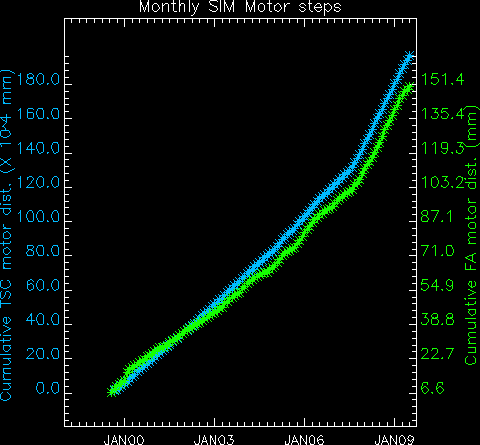
|
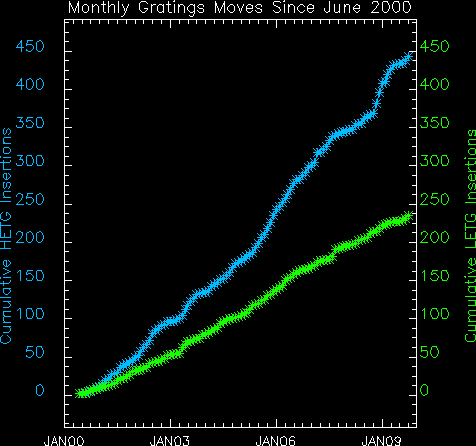
|

Reaction Wheel Rotations

Links to Past Monthly Reports
| Year | Month | |||||||||||
|---|---|---|---|---|---|---|---|---|---|---|---|---|
| 1999 | Jul | Aug | Sep | Oct | Nov | Dec | ||||||
| 2000 | Jan | Feb | Mar | Apr | May | Jun | Jul | Aug | Sep | Oct | Nov | Dec |
| 2001 | Jan | Feb | Mar | Apr | May | Jun | Jul | Aug | Sep | Oct | Nov | Dec |
| 2002 | Jan | Feb | Mar | Apr | May | Jun | Jul | Aug | Sep | Oct | Nov | Dec |
| 2003 | Jan | Feb | Mar | Apr | May | Jun | Jul | Aug | Sep | Oct | Nov | Dec |
| 2004 | Jan | Feb | Mar | Apr | May | Jun | Jul | Aug | Sep | Oct | Nov | Dec |
| 2005 | Jan | Feb | Mar | Apr | May | Jun | Jul | Aug | Sep | Oct | Nov | Dec |
| 2006 | Jan | Feb | Mar | Apr | May | Jun | Jul | Aug | Sep | Oct | Nov | Dec |
| 2007 | Jan | Feb | Mar | Apr | May | Jun | Jul | Aug | Sep | Oct | Nov | Dec |
| 2008 | Jan | Feb | Mar | Apr | May | Jun | Jul | Aug | Sep | Oct | Nov | Dec |
| 2009 | Jan | Feb | Mar | Apr | May | Jun | Jul | Aug | Sep | |||
